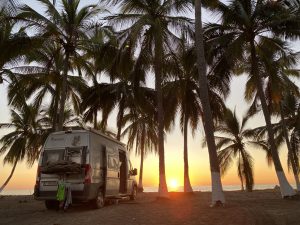 After the last couple of weeks in Southern Baja California (a favorite winter retreat for Americans and Canadians), the arrival in Mazatlan was a bit of shock again. But in a positive way. This is the Mexico that we know and love from our previous travels. The country where Caroline and myself got together over 14 years ago. Baja was very nice but it somehow felt that we now had finally arrived in the real Mexico.
After the last couple of weeks in Southern Baja California (a favorite winter retreat for Americans and Canadians), the arrival in Mazatlan was a bit of shock again. But in a positive way. This is the Mexico that we know and love from our previous travels. The country where Caroline and myself got together over 14 years ago. Baja was very nice but it somehow felt that we now had finally arrived in the real Mexico.
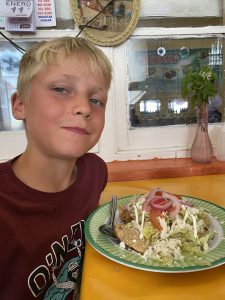 The state of Sinaloa, of which Mazatlan is the capital, is considered a ‘do not travel’ area due to heavy cartel activity. We planned to not spend too much time in the area but did want to visit the town itself. This was partly motivated by the fact that by the time we got off the ferry, it was already quite late in the morning and we would not have enough time to get in to safer areas before dark. We were not particularly blown away by the city but it had some nice squares, beach front, colonial buildings and a Mercado with great food. We had a quiet night, parked in a residential neighborhood. And as soon as it became light, the next morning we started our drive out of the state. We chose to drive the ‘toll ways’ as they are considered safer. They are really expensive though and so there is hardly anybody using them. Ironically, they maybe be safer from a crime point of view, but they are also the main ‘operating area’ for Mexico’s famous corrupt police forces. Whoever is driving the toll highway has money and wants to move forward fast. So many travelers are being stopped for (imaginary) traffic infractions and are offered the possibility to pay a ‘fine’ (bribe) to be able to continue quickly or to be detained for a long time. Luckily we got a lot of tips from other travelers on how to handle these situations, but it stays an annoying phenomenon. It is definitely not exclusive for Mexico but it is really rampant there.
The state of Sinaloa, of which Mazatlan is the capital, is considered a ‘do not travel’ area due to heavy cartel activity. We planned to not spend too much time in the area but did want to visit the town itself. This was partly motivated by the fact that by the time we got off the ferry, it was already quite late in the morning and we would not have enough time to get in to safer areas before dark. We were not particularly blown away by the city but it had some nice squares, beach front, colonial buildings and a Mercado with great food. We had a quiet night, parked in a residential neighborhood. And as soon as it became light, the next morning we started our drive out of the state. We chose to drive the ‘toll ways’ as they are considered safer. They are really expensive though and so there is hardly anybody using them. Ironically, they maybe be safer from a crime point of view, but they are also the main ‘operating area’ for Mexico’s famous corrupt police forces. Whoever is driving the toll highway has money and wants to move forward fast. So many travelers are being stopped for (imaginary) traffic infractions and are offered the possibility to pay a ‘fine’ (bribe) to be able to continue quickly or to be detained for a long time. Luckily we got a lot of tips from other travelers on how to handle these situations, but it stays an annoying phenomenon. It is definitely not exclusive for Mexico but it is really rampant there.
We did see the police present in great force on these highways. Often in some kind of ambush in ‘confusing traffic situations’. In the end, during all our time in Mexico, we were only stopped once by the police for such an ‘imaginary infraction’ but once they saw the kids they let us go pretty easily.
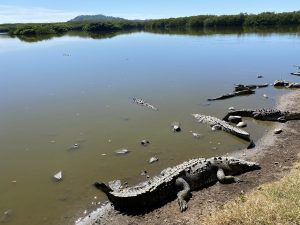 Apart from the police we also quickly noticed the big difference in climate and fauna & flora. During our ferry ride we had crossed into the tropics and that could be felt and seen. After a month of desert scapes in Baja, everything was now bright green. The birds became a lot more colourful and the others animals more exotic. We even saw our first crocodiles of the trip.
Apart from the police we also quickly noticed the big difference in climate and fauna & flora. During our ferry ride we had crossed into the tropics and that could be felt and seen. After a month of desert scapes in Baja, everything was now bright green. The birds became a lot more colourful and the others animals more exotic. We even saw our first crocodiles of the trip.
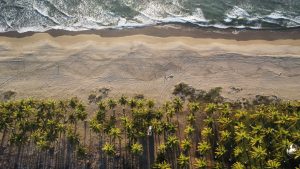 We spent the night under the coconut trees and had originally planned to go surf on a nearby beach. Unfortunately the surf forecast was very bad so we decide to leave (after almost two months) the Pacific coast and head in land.
We spent the night under the coconut trees and had originally planned to go surf on a nearby beach. Unfortunately the surf forecast was very bad so we decide to leave (after almost two months) the Pacific coast and head in land.
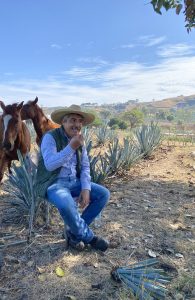 When entering the state of Jalisco, the landscapes in the distance seem to have a blue shine to them. When we got closer we realised these are the Blue Agave plants. These plants are the main ingredient for the most famous Mexican drink: Tequila! And similar to the wine regions only the drinks made in the town of Tequila can use the name ‘Tequila’. We camp on the grounds of a small family distillery and we learn all about the production of Tequila during a tour with the owner Jose . We found out that it takes about 9 years before these agave plants are mature enough to produce the tequila. All this time there is hardly any maintenance on the plants. These desert survivors are excellent water managers that suck up and store water whenever they can (rain but also dew) and then slowly use it in the growth process. After 9 years the heart of the plant (a big ball like root) is dug up, cut into pieces and cooked. Fermentation does the rest. At the end of the tour at 11 am we have a tasting session…So we don’t do much else in the afternoon
When entering the state of Jalisco, the landscapes in the distance seem to have a blue shine to them. When we got closer we realised these are the Blue Agave plants. These plants are the main ingredient for the most famous Mexican drink: Tequila! And similar to the wine regions only the drinks made in the town of Tequila can use the name ‘Tequila’. We camp on the grounds of a small family distillery and we learn all about the production of Tequila during a tour with the owner Jose . We found out that it takes about 9 years before these agave plants are mature enough to produce the tequila. All this time there is hardly any maintenance on the plants. These desert survivors are excellent water managers that suck up and store water whenever they can (rain but also dew) and then slowly use it in the growth process. After 9 years the heart of the plant (a big ball like root) is dug up, cut into pieces and cooked. Fermentation does the rest. At the end of the tour at 11 am we have a tasting session…So we don’t do much else in the afternoon
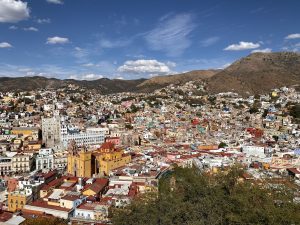 We decide to skip Guadalajara, the second biggest town in Mexico but also a traffic nightmare and go straight to the city of Guanajuato. This town had been recommended to us by many travelers and we soon learned why. The city that is spread out over several hills is probably the most colourful big city that we have ever seen. There are really nice small streets, cosy squares, beautiful churches and colonial architecture all around town. But what makes the town really special are the tunnels and viewpoints. The tunnels are built to connect neighborhoods that are separated by the hills and cliffs. They are not only used by cars but also by pedestrians and it feels like a hidden city. The viewpoints on the top of the hills really make you appreciate all the colors but also give a goof idea of the size of the city. From every viewpoint you discover another part of the city. It feels almost like a completely different town every time. Our campsite also has a really nice view and good company. But we will especially remember the narrow and very steep streets to get in. One wrong turn in this city and you can be in a lot of navigation trouble. And you better not try to follow any GPS…
We decide to skip Guadalajara, the second biggest town in Mexico but also a traffic nightmare and go straight to the city of Guanajuato. This town had been recommended to us by many travelers and we soon learned why. The city that is spread out over several hills is probably the most colourful big city that we have ever seen. There are really nice small streets, cosy squares, beautiful churches and colonial architecture all around town. But what makes the town really special are the tunnels and viewpoints. The tunnels are built to connect neighborhoods that are separated by the hills and cliffs. They are not only used by cars but also by pedestrians and it feels like a hidden city. The viewpoints on the top of the hills really make you appreciate all the colors but also give a goof idea of the size of the city. From every viewpoint you discover another part of the city. It feels almost like a completely different town every time. Our campsite also has a really nice view and good company. But we will especially remember the narrow and very steep streets to get in. One wrong turn in this city and you can be in a lot of navigation trouble. And you better not try to follow any GPS…
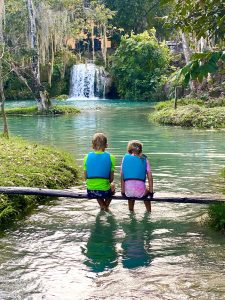 As much as we loved Guanajuato (our new favourite Mexican town, sorry Oaxaca!), we like nature better and so we decide to head back north to the Huasteca Potosina region. This region with thousands of waterfalls, used to be a well kept secret where only Mexicans went. But since a couple of years the guide books have also picked it up. And that is no wonder because it is a really beautiful region. We spent more than a week visiting several places. We went snorkeling in the Laguna de Media Luna and camped a weekend at Agua Buena. But our favourite place was probably the Puente de Dios where we could swim from one clear blue pool to the other via some caves. The big Tamul waterfalls were also really nice but unfortunately this was one of these places that have become very famous almost overnight. And the locals (not used to tourists) are trying (in all kind of ways) to get as much money as fast as possible. They force you into all kind of organized/guided tours where the guide has little to no added value. Which is not really optimal for the ‘independent visitor’ experience unfortunately.
As much as we loved Guanajuato (our new favourite Mexican town, sorry Oaxaca!), we like nature better and so we decide to head back north to the Huasteca Potosina region. This region with thousands of waterfalls, used to be a well kept secret where only Mexicans went. But since a couple of years the guide books have also picked it up. And that is no wonder because it is a really beautiful region. We spent more than a week visiting several places. We went snorkeling in the Laguna de Media Luna and camped a weekend at Agua Buena. But our favourite place was probably the Puente de Dios where we could swim from one clear blue pool to the other via some caves. The big Tamul waterfalls were also really nice but unfortunately this was one of these places that have become very famous almost overnight. And the locals (not used to tourists) are trying (in all kind of ways) to get as much money as fast as possible. They force you into all kind of organized/guided tours where the guide has little to no added value. Which is not really optimal for the ‘independent visitor’ experience unfortunately.
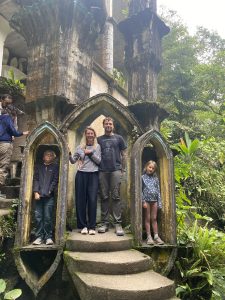 We had a lovely time in the Huasteca Potosina but it is now time to start driving south again. But not without a stop at Las Pozas. This ‘surrealist sculpture garden’ was built by poet, genius/mad man and Forbes inheritor Edward James. In the 80 acres domain he tried to recreate a world based on paintings from Magritte, Dali and others. Today the buildings are slowly being taken over by nature which makes it a very atmospheric place.
We had a lovely time in the Huasteca Potosina but it is now time to start driving south again. But not without a stop at Las Pozas. This ‘surrealist sculpture garden’ was built by poet, genius/mad man and Forbes inheritor Edward James. In the 80 acres domain he tried to recreate a world based on paintings from Magritte, Dali and others. Today the buildings are slowly being taken over by nature which makes it a very atmospheric place.
We continue on our way through the reserve Sierra Madre, visiting a couple of old Spanish missions on the way. We were very surprised to find out that these missions had been set up by the same Spanish Franciscan priest that also founded missions all the way north in California. The road over the Sierra Madre mountains led us to villages that looked a lot like some places in Nepal. Only the omnipresent taco stands gave away that we were still in Mexico.
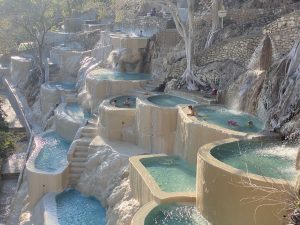 As we descended from the lush mountains of the Sierra Madre, we entered a semi desert again. Before continuing further south we still wanted to visit another Mexican classic: the hot springs and caves of Tolantongo. The hot river that emerges from the caves has been a holiday or weekend destination for Mexicans for years. We would never have found out about if it wasn’t for a very photogenic new section that has been added in the last couple of years and became a huge hype on Instagram: a hillside full of ‘hanging pools’ with an amazing view on the valley below.
As we descended from the lush mountains of the Sierra Madre, we entered a semi desert again. Before continuing further south we still wanted to visit another Mexican classic: the hot springs and caves of Tolantongo. The hot river that emerges from the caves has been a holiday or weekend destination for Mexicans for years. We would never have found out about if it wasn’t for a very photogenic new section that has been added in the last couple of years and became a huge hype on Instagram: a hillside full of ‘hanging pools’ with an amazing view on the valley below.

alles prachtig….met uitzondering van de kroko’s
Geweldig !